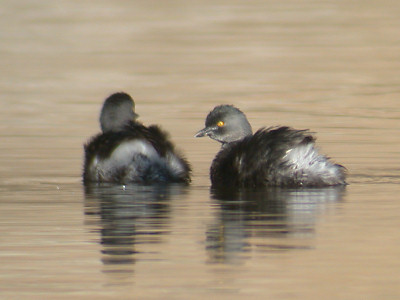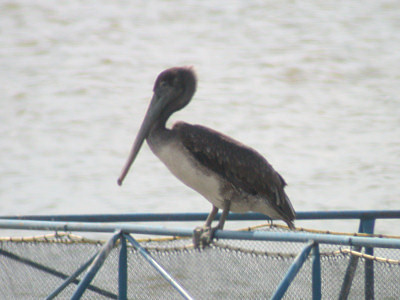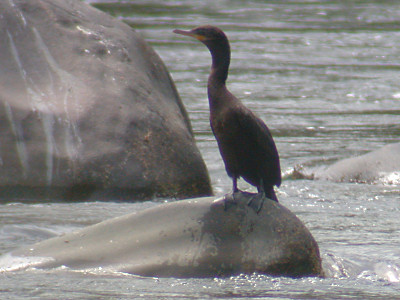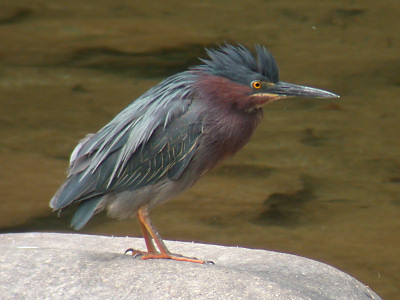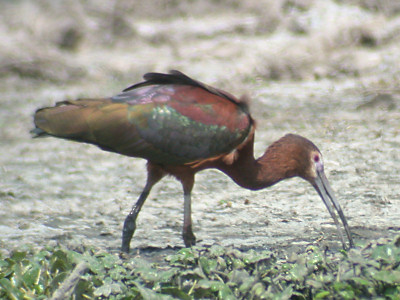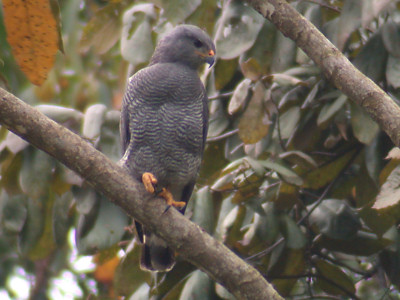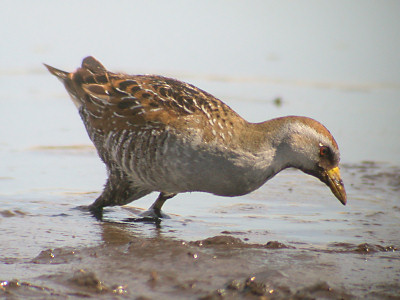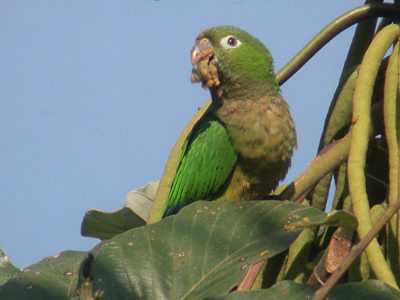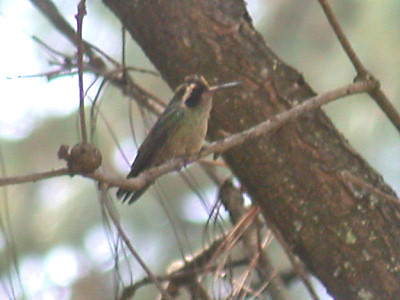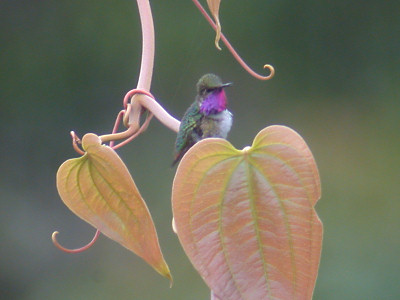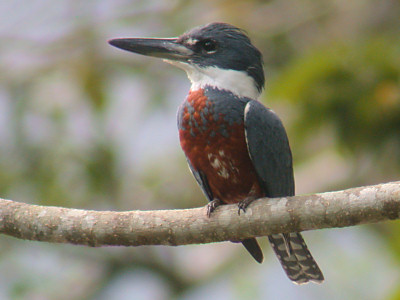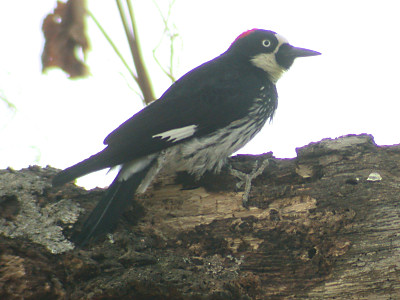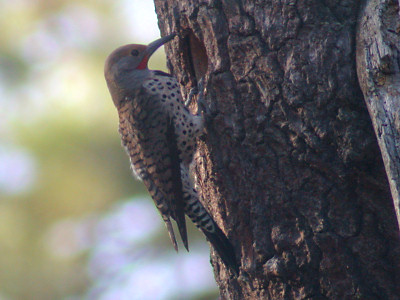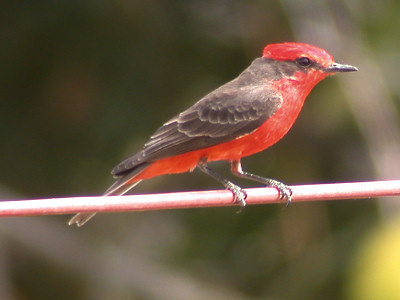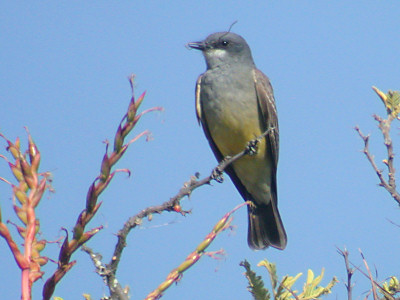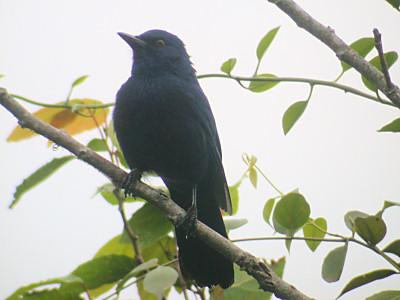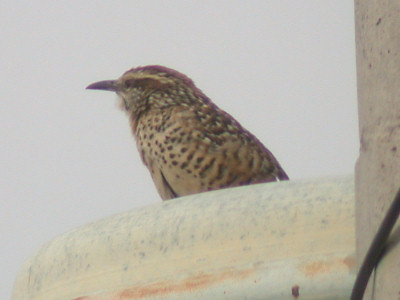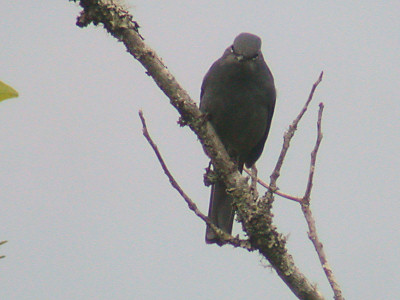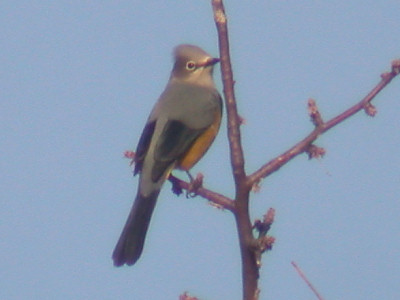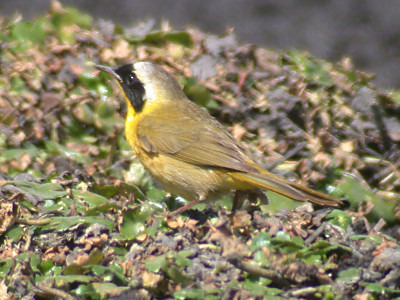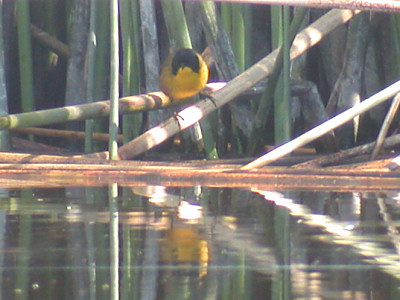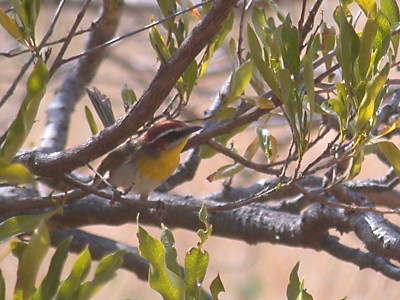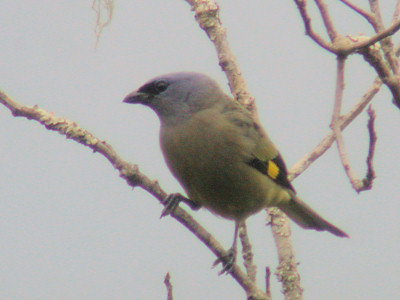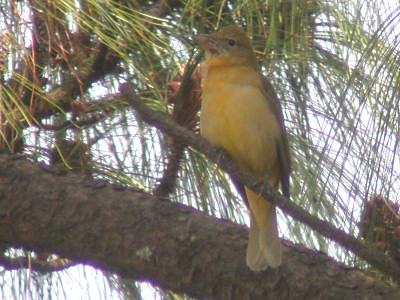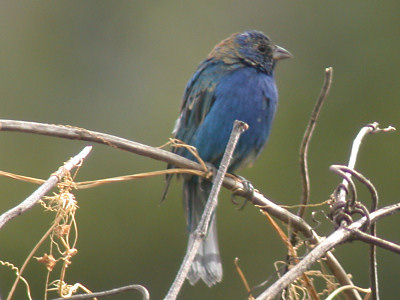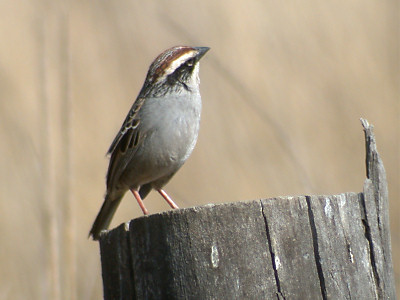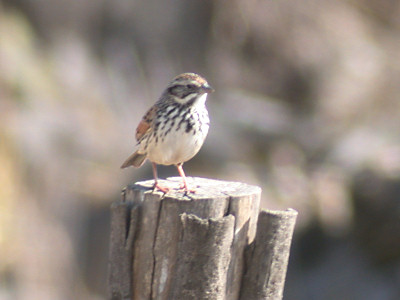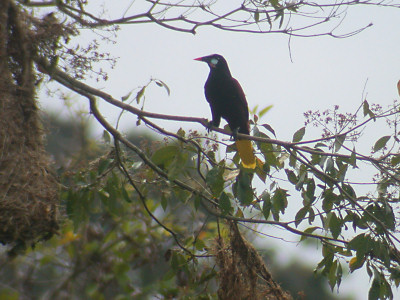Birding Trip Report Central Mexico (Toluca, Oaxaca, Valle Nacional) in March
2008
Sjaak Schilperoort (sjaak at
xs4all.nl)
Tineke Hooijmans (cmhooijmans at
gmail.com)
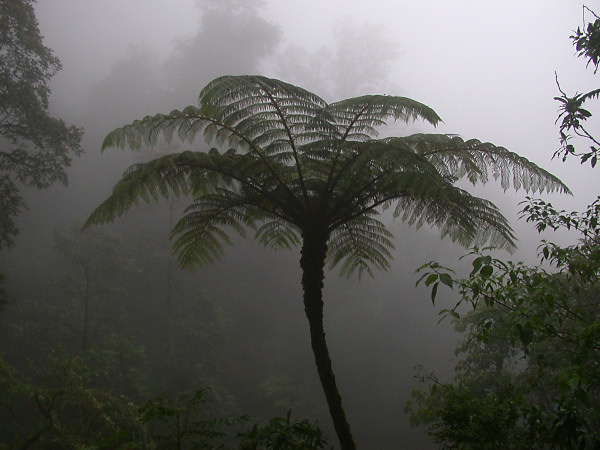 A tree fern in the cloud forest above Valle
Nacional
A tree fern in the cloud forest above Valle
Nacional
Introduction
From March 8 to 24, 2008 I went on a bird watching trip to central Mexico. It
was my first visit to Mexico. Tineke went on her third business trip to Toluca,
for 2 weeks. I joined her the second week, and after that we went to Oaxaca
together for a week birding. I'm very fortunate to have parents that are young
in spirit and very fond of their grand children. They offered to take over the
care for our three children (9, 14 and 15 years old) for these two weeks.
Preparation
I've used the following documentation to prepare for the trip:
-
A Guide to the Birds of Mexico and North Central America -
Steve N.G. Howell and Sophie Webb, 1995. Excellent guide, but having 850
pages it is a bit awkward to carry along. Most N-A species are not
illustrated. As I'm not familiar with some families, most notably the
warblers, I needed a second guide with me.
-
Field Guide to the Birds of North America - 2nd edition,
National Geographic Society, 1983. This supplements the Mexican guide with
N-A species.
-
Where to watch birds in Mexico - Steve
N.G. Howell, 1999. Based on visits from 1980 up to 1998. I've found the
areas, directions and bird lists still valid.
-
Internet trip reports. Most (if not all) of these trips were based on the
bird finding book of Howell. They added in the form of actuality and local
details. Especially the trip report by Garry Bakker
(http://www.travellingbirder.com/tripreports/reports/mexico_birding_trip_report_dec-03.pdf)
was a pleasant read.
-
Birds of Mexico, MP3 Sound Collection - Peter Boesman. I
transferred the complete CD to my mp3-player. I found coverage to be almost
complete. In the field I missed only one recording: the song of the Oaxaca
Sparrow.
-
Lonely Planet Guide for Mexico, Forsyth
et al, 2002. Used for finding information on accommodations and culture.
Furthermore, I've obtained a map for my Garmin 60csx GPS device from Mexico Maps
(http://www.mexicomaps.com/).
This turned out to be quite essential in finding my way around. The map contains
roads, topography (height contours), city plans of all major cities, and
includes routing capabilities. I've prepared for the trip by locating the areas
described in the Howell bird-finding book on Google Maps
(http://maps.google.com/),
and then load these locations as waypoints in my Garmin (waypoints are available
on request). The quality of the map information turned out to be high in popular
and tourist areas, and was lacking somewhat in more remote areas. The Mexico
City street plan was detailed and accurate, but computing a route through the
city took almost 2 minutes. Making an error in navigating a route thus led to a
short "black out". Nevertheless, when leaving Toluca for Oaxaca, we passed
Mexico City within 2 hours of driving time. Couldn't have done this without
navigational support.
General
Transport
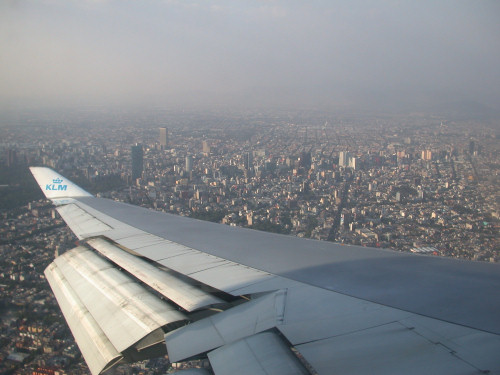 View on the Mexico City metropolis just before
landing
View on the Mexico City metropolis just before
landing
Flight reservation was done through KLM, the regular flight (KL685) to Mexico
City. We only had to buy one extra ticket, which cost EUR 880.
I made a rental car reservation for the full period through SunnyCars
(http://www.sunnycars.com/).
Prices were comparable to dealing with car rental companies directly, but with
SunnyCars insurance and conditions were much clearer. I didn't have any
experience with this company, but read some favorable comments on the Internet.
We got a Chevrolet Chevy (= Opel Corsa) through Alamo for 660 EUR (15 days, two
drivers). Service at Alamo was fast and friendly. Returning the car was hassle
free. The car was a bit small. It could just hold all our luggage in the trunk
and the back seats. But the motor was powerful enough to drive comfortably into
the mountains and to climb the Toluca volcano. It could overtake trucks and
buses with ease. And it could fit in tight parking spaces, which was handy in
Oaxaca center. We drove 2843 kilometers.
Next time we might consider using public transport for at least part of the
time, and only hire a car when necessary to reach some places in time. Public
transport seems to be very well organized and easy to use.
Hotels
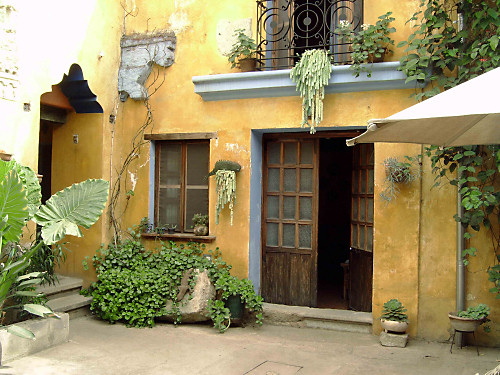 View from the patio on our apartment in La Casa de
Los Abuelos, Oaxaca
View from the patio on our apartment in La Casa de
Los Abuelos, Oaxaca
The first week we stayed in Holiday Inn Express in Toluca. This cost us nothing,
as it has been arranged as part of my Tineke's business trip. The luxury that
came with it included a private parking garage, breakfast & snacks, free
wireless Internet. Time difference permitting, we could talk at length with our
children by setting up a voice connection through Internet.
The second week we found a very nice, quiet and secure apartment in Oaxaca, "La
Casa de Los Abuelos", C. de Reforma 410
(http://lacasa-de-rosita.com/).
This is a building that has been turned into a set of 8 apartments around a
patio. The apartments are situated right next to the Santo Domingo plaza, which
is a center point for evening festivities. We had two floors, a living room and
kitchen with refrigerator, gas stove and microwave downstairs, and a bedroom
with toilet and shower upstairs. The price of $500 (EUR 30) per night was very
reasonable. The service included a PC and wireless Internet.
From Oaxaca we made a two-day trip to Valle Nacional, and stayed in Hotel des
Valles for $380 (EUR 23) per night. The hotel was very basic. It didn't have
Internet, and facilities were limited to a bed, A/C and a hot shower. We got a
remote control for the TV set, but there was no antenna connection. We arrived
during the "Fiesta del Pueblo", which was a crossover between a fair and a
market. The evenings were very noisy. This didn't bother us very much as we
immediately fell in sleep from exhaustion each night. We were woken in time
again by roosters and grackles in the backyard.
On the way back from Oaxaca to Mexico City we wanted to find a hotel in the
vicinity of Mexico City for the last night. We had chosen Atlixco as a location
to find a hotel. Several love (auto) hotels were present, but this didn't fancy
us much. We found "Hotel Esperanza", $320 (EUR 20) to be one of the very few
alternatives. A very plain hotel, in a very plain Mexican town. There was no
Internet in the hotel, but the town held two Internet cafes.
Traffic
Traffic in Mexico was confusing at first. But very soon I got used to the way
people react on each other (actually not very different from car drivers in
Holland) and had no problems navigating through traffic. When you want to change
lanes it is best to just start the maneuver and let other people see that you
are serious about it. Everyone wants to avoid a collision, so eventually you
will get room. People may (and will) honk anyway. On the other hand, if you
signal that you want to change lanes and wait for people to give you space, you
may never get the opportunity. People will simply cut you off as fast as they
can.
People honk very often, for instance when you don't react quick enough to a
traffic light changing to green, or when they want to pass on the right, or
think you are doing something wrong, etc.. Be relaxed about it and don't take it
personally. I even started to recognize and appreciate this extra form of
communication.
When passing towns or buildings of any kind, you should be very aware of "topes"
or speed bumps. Their presence is not always indicated, but most of them are so
steep that they can only be passed without damage to your car by approaching
them with near-zero speed. This severely hampered my action radius around
Toluca. I was not able to visit the more remote places, due to the staggering
amount of topes that I needed to cross to get out of the Toluca valley and the
time this would take.
Sometimes the right side lane of a road will switch to the other side. This is
something to be aware of if you come from a small side street. It is not always
obvious which lane you should enter. It is best to trust on the other traffic
and go with the flow until you are familiar with the local situation. At quiet
hours (early in the morning) I ended up going against the traffic several times.
When a bus or truck in front of you signals to the left, this could mean that
you can pass. This is the exact opposite (and in my opinion also more confusing)
from what is custom in European countries.
Wherever highway traffic is slowing down, especially on the toll ways or cuotas,
people try to sell stuff. Mostly food, but also cigarettes, toys and even poodle
puppies. Although we didn't have any bad experience, we made a habit of locking
our car from the inside when traffic was not moving.
There was a lot of road kill, but strangely enough not a single bird amongst it.
Most victims were dogs, sometimes cats and I even saw some dead donkeys.
Food
Food in Mexico is excellent, fresh and cheap, and is prepared very fast. I like
spicy dishes and love the salsas that accompany most meals. We are both
vegetarians, and although Mexicans eat a lot of meat, restaurants offer enough
alternatives. Most food is prepared fresh, so a vegetarian version of a dish can
often be prepared ad hoc. Only in Valle Nacional choices were very limited. The
open-air restaurant across the street from the Pemex station was decent though.
Sometimes we didn't take the trouble of finding something and based a dinner on
avocado's, taco's, lime, tomatoes, bread and bear at our hotel room.
One time we both got indigestion problems. The cause was most probably a dish
with fresh lettuce in the luxurious Hotel Del Rey Inn, Toluca. In the course of
the next day stomach problems forced me to loose my breakfast along the road. As
things didn't improve, I got back to the hotel and recovered only after a solid
16 hours sleep. After recovery, Tineke started to have similar symptoms. She
also recovered within a day. We refrained from eating lettuce, strawberries,
basil leaves, etc. after this experience. A colleague of Tineke supplied us with
Bactrim, a medicine that most Mexicans have in store for this kind of situation.
It seems to be a cocktail of different kinds of penicillin. It should help
within 8 hours, can be bought without a subscription but can have severe side
effects. Luckily we didn't need it.
Weather
The first days in Mexico were partly cloudy. On Toluca Volcano it was just above
freezing point, and at the top we had some light snow coming down. Toluca and
the surrounding valley was rather cool. Temascaltepec is at a much lower
elevation and was alsoa much warmer than Toluca. Due to the clear skies the
number of swifts at that location was low. I only saw small numbers of Vaux's
Swifts. During our stay in Toluca, the afternoon temperature was increasing
gradually. When we went to Oaxaca for the second week it was sunny and warm, and
in Oaxaca afternoons were close to 35 degrees Celsius. The mornings started
rather warm as well. Maybe as a consequence of this, morning bird activity in
the Oaxaca valley was low. Even at sunrise very few birds sang. I tried at
several places, but I couldn't find Oaxaca Sparrow or Dwarf/Slaty Vireo (did
hear the vireo songs though, replayed at 100 dB by a large excursion of British
people at Teotitlán. I guess this scared the hell out of any vireo present).
The climate in the mountains of Cerro San Felipe was nice. Not very hot and
almost no wind. Perfect conditions for trying to find songbirds. We had
excellent views of two singing Mountain Trogons, and managed to see two Dwarf
Jays. We went to Valle Nacional during a short period of cloudy and cool
weather. This made the cloud forest look as it is supposed to. The road cut
through dense clouds. The surrounding vegetation produced it's own rain. Very
impressive. At times we had good sight, and bird activity was high throughout
the day. The next days brought clearer skies and warm afternoons again. The
cloud forest went quiet, but birds the lowlands were still very active.
On the way back to Oaxaca and from there to Mexico City it was hot, dry and
sunny again.
Red Tape
At Coajamulco military people had set up a roadblock of some sort. They let me
pass on the way to Coajamulco, but stopped me when I returned several hours
later. It looked like boys doing military service and having some sort of vague
assignment. I had to supply name, origin and destination that were written down
on a block note that showed I was their first "suspect". Apparently Mexican
drivers are not stopped so easily. While trying to answer the Spanish questions,
the front of the car was searched superficially. My tripod, telescope,
binoculars and camera on the back seat must have looked very suspect, but didn't
trigger any reaction. Instead without even checking my gear they told me I could
continue my trip.
When we passed Mexico City, and were searching for the Puebla cuota, a Mexico
City traffic policeman stopped us. The traffic police is infamous for the
practice of getting money out of tourists by letting them pay off a possible
traffic violation fine. I've read trip reports of people that actually paid
money and felt very frustrated by this situation afterwards. After three visits
to Mexico, Tineke was somewhat familiar with the Mexican way of dealing with
life and was prepared for this situation. The strategy is to stay very polite
but refuse to pay. Stall time, offer to go to the police station to settle
things, request name and identification of the police officer, explain that you
need this information to inform your embassy, etc.. Eventually the police
officer will loose interest as it doesn't pay off, and will search for a more
cooperative victim. However, we did not have to do all this. It appeared to be
sufficient to pretend not to speak any Spanish (not entirely true) and explain
in careful English that we actually did signal a right turn (which the policeman
said we did not). After 5 minutes of exchanging English vs. Spanish we got our
drivers' license and car rental papers back and were waved away. This really
made our day!
In Cerro San Felipe, the forest above Oaxaca city, it is well known that the
locals ask money from birdwatchers entering the area. The road into the forest
is provisionally closed with a chain (can be loosened without the need for
unlocking). After some discussion with a man selling admission tickets it turned
out that we were supposed to pay $50 per person. This was a ridiculous price
compared to the Mexican standard, but I decided not to make a fuss about it and
paid. We found two Dwarf Jays, so maybe it was worth the price after all.
When we watched birds from highway 175, in the cloud forest above Valle
Nacional, a car stopped nearby and three men approached us. Two carried
walkie-talkies, a third one had binoculars. They were not in uniform of any
sort. They asked us if we had a "permiso de las autoridades" to stop and watch
birds along the highway. We repeated our successful strategy to not understand
any Spanish. This caused confusion amongst the men. They started discussing what
the hell "permiso" was in English. I had difficulties to keep a straight face.
We added to the confusion to confer in Dutch. When they didn't make any progress
on the translation, we friendly said goodbye, entered our car and drove to
another stop, a few kilometers down the road. After a short time they passed
again, this time without stopping. Although the men looked harmless, this was
the only time during our stay we felt a bit uncomfortable about the situation.
Itinerary
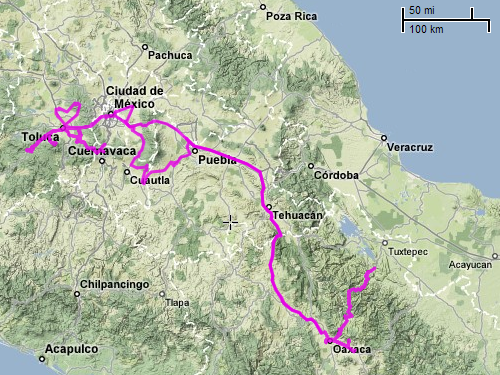 The GPS track data from our
trip
The GPS track data from our
trip
Here is an overview of all the trips we made. The numbers refer to
locations described in the bird-finding book of Howell.
8-3-2008: Flight to Mexico City, picked up rental car, drove to Holiday Inn
Express, Toluca
9-3-2008: Top of Toluca Volcano (morning), Lerma Marshes (8-8, afternoon)
10-3-2008: Foot of Toluca Volcano (morning), Temascaltepec & Polvorín Loop
(end of morning and afternoon)
11-3-2008: La Cima (8-4, morning), Coajamulco (8-5, afternoon)
12-3-2008: CIRA-UAEM Institute (morning), Colonia Centro Ceremonial Otomi
(afternoon)
13-3-2008: Temascaltepec (8-9, morning, trip broken off due to illness)
14-3-2008: Lerma Marshes (8-8, morning and first half of the afternoon)
15-3-2008: From Toluca to Oaxaca
16-3-2008: Cerro San Felipe (11-5, morning), Tule (afternoon)
17-3-2008: Teotitlán del Valle (11-2, morning), Yagul (11-3, afternoon)
18-3-2008: Monte Alban (11-1, morning), a visit to the ruins after that.
19-3-2008: From Oaxaca to Valle Nacional (11-6)
20-3-2008: Highway 175 above Valle Nacional (11-7, whole day)
21-3-2008: From Valle Nacional to Oaxaca (11-6)
22-3-2008: Teotitlán del Valle (11-2, morning), Oaxaca to Atlixco
23-3-2008: Tlacotepec (8-7, morning), Mexico City airport, drop off rental car,
return flight to Amsterdam
On 9-3 the trips were made by Tineke, two colleagues of her, and me. On 10-3,
11-3 and 14-3 I birded alone, as Tineke had to work. The rest of the trips were
made by Tineke and me together, except for 22-3 when I did some (in vane)
endemic-hunting by my own.
Areas visited
Toluca Volcano
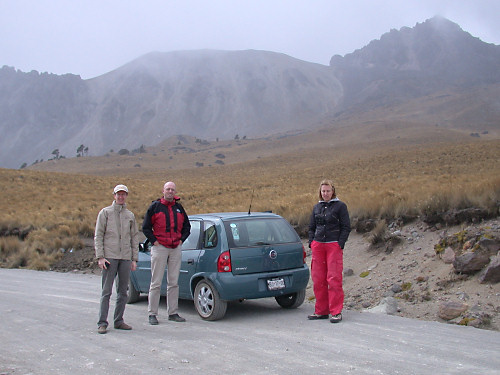
The ascent of the Toluca Volcano, with Tineke and two
colleagues of hers
On 9-3-2008, my first day in Mexico, I went up to the Toluca Volcano with Tineke
and two of her colleagues. We first birded in the forest at the start of the
unpaved road, trying to find Strickland's Woodpecker. We didn't find it, but we
had some nice views of a male Rufous
Hummingbird (perched at close range),
Mexican Chickadee,
Striped Sparrow,
Yellow-eyed Junco,
Eastern Bluebird (very common),
Red Warbler (spectacular),
Bewick's Wren,
American Robin. After that we continued the
road to the crater. However, clouds were moving in and it started to snow. Alas,
we didn't have much of a view from the top. Also, at 4240 m I was feeling really
dizzy. We quickly took some pictures and returned to a more tolerable height. We
only saw birds again (Striped Sparrows being the first) until we approached the
tree line at approximately 3000 m.
On 10-3-2008 I visited the start of the unpaved road again. Again missed the
Strickland's Woodpecker. Found
Northern
Flicker 2, Mexican Chickadee,
Brown Creeper 4,
Pygmy Nuthatch, Red
Warbler and Yellow-eyed
Junco.
Lerma Marshes
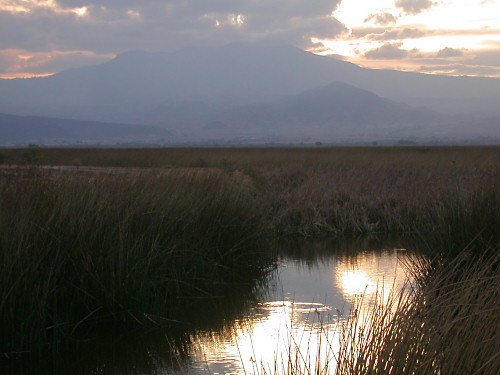
Lerma Marshes at dusk, with Toluca Volcano in the
background
I've visited the Lerma Marshes twice. First an afternoon visit on 9-3 with
Tineke and a colleague. I revisited the area on my own on 14-3, from early in
the morning until early in the afternoon.
The water level in the marsh was rather low. Large areas of reed were growing on
dried out mud flats. These reed beds were often burnt down, which seems to be a
common practice in Mexico. Also, the unpaved road that Howell described was
blocked after 0,5 km by a pile of stones and rocks, presumably to repair the
road. It took some navigation to find a way around this, and get to some good
marsh habitat. I found this approximately 1,5 km further down the road. There,
the endemic Black-polled Yellowthroat was an
easy find. Later on, I also found some Black-polled Yellowthroats near the fish
tanks.
The birds observed in and around the marsh during the afternoon and evening
visit on 8-3 include Pied-billed Grebe,
Great Blue Heron 10,
Great Egret, Snowy
Egret, Cattle Egret (evening
flights of >100 birds), Black-crowned
Night-Heron 8, White-faced Ibis
100, Green-winged Teal,
Blue-winged Teal,
Northern Harrier 4,
Sharp-shinned Hawk 1,
Red-tailed Hawk 1,
American Kestrel,
Common Moorhen,
American Coot,
Killdeer, Greater
Yellowlegs 4, Least Sandpiper,
Long-billed Dowitcher 20,
Common Snipe 2,
Laughing Gull 1 winter plumage (only gull
seen on this trip), Mourning Dove,
Inca Dove,
Short-eared Owl 1 flying around with a
mouse, Buff-breasted Flycatcher,
Say's Phoebe, Barn
Swallow, American Pipit 1,
Loggerhead Shrike 1,
Northern Waterthrush 1,
Common Yellowthroat (out-numbering
Black-polled by about 4 to 1), Wilson's
Warbler, Striped Sparrow,
Song Sparrow,
Yellow-headed Blackbird,
Red-winged Blackbird,
Bronzed Cowbird,
Brown-headed Cowbird,
Great-tailed Grackle,
House Finch.
The second visit on 14-3 added species such as Northern
Shoveler 3,400, Ruddy Duck 1,600,
Gadwall 4, Eared
Grebe 50, Cinnamon Teal 4,
Sora 2,
Black-necked Stilt 4, American
Avocet 60, Spotted Sandpiper 2,
Wilson's Phalarope 8,
Vermilion Flycatcher,
Cassin's Kingbird,
Marsh Wren 1,
Canyon Towhee,
Grasshopper Sparrow, and
European Starling 10. To my surprise, just
before I left I noticed an immature Brown
Pelican that has appeared on the fish tanks.
During my visit a man with a catapult was hunting on birds from the road. He was
carrying a killed Snowy Egret, and was also aiming at Eared Grebes.
Temascaltepec
On 10-3-2008 I paid a first visit to the Temascaltepec area and the Polvorín
loop (as Howell calls this in his bird-finding book). I arrived several hours in
the morning, after visiting the foot of Toluca Volcano first. Tried to do the
swifts anyway, from a stop about 1 km from the Pemex station, at a steep drive
way up to a hill-side house. I saw some decent numbers of
Vaux's Swift from there, but nothing else.
After that I birded along the way from Temascaltepec to Real de Arriba, and from
Real de Arribo into the hills. Especially the start of the unpaved road from
Real de Arribo was very birdy. I identified the following species:
Black Vulture,
Turkey Vulture,
Inca Dove,
Groove-billed Ani 1,
Vaux's Swift >100,
Berylline Hummingbird >20,
Broad-tailed Hummingbird 1 male,
Acorn Woodpecker 2,
Ladder-backed Woodpecker 1 female,
Canyon Wren 1 heard,
Tufted Flycatcher 2,
Vermilion Flycatcher,
Cassin's Kingbird,
Thick-billed Kingbird,
Northern Rough-winged Swallow,
Spotted Wren 1,
Eastern Bluebird,
Curve-billed Thrasher 3,
Grey Silky,
Nashville Warbler,
Black-throated Grey Warbler,
MacGillivray's Warbler,
Wilson's Warbler,
Rufous-capped Warbler,
Black-headed Grosbeak,
Indigo Bunting,
Varied Bunting,
Canyon Towhee,
Clay-colored Sparrow,
Song Sparrow,
Scott's Oriole 1 male,
Baltimore Oriole 1 female,
House Finch, Lesser
Goldfinch, House Sparrow.
On 13-3-2008 I returned to the area, together with Tineke who had arranged a day
off from work. We saw some new species, but had to return when I became ill from
food poisoning and didn't recover in the field. Species observed during our
short visit: White-eared Hummingbird,
Berylline Hummingbird,
Green Kingfisher (found by Tineke),
Acorn Woodpecker,
Bridled Titmouse,
Canyon Wren (singing on a roof),
Happy Wren,
Ruby-crowned Kinglet,
Townsend's Warbler and
Hepatic Tanager 1 female.
La Cima
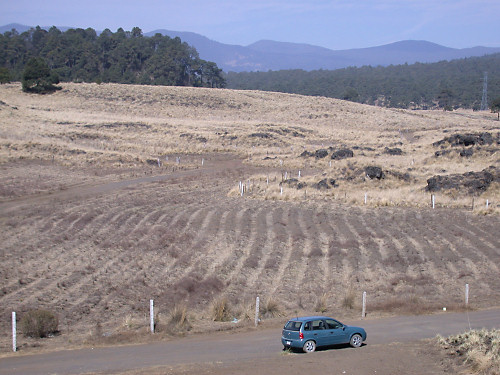 Sierra Madre Sparrows were present at the backside of
this field
Sierra Madre Sparrows were present at the backside of
this field
On 11-3 I went to La Cima in the morning, a reliable site to see the endangered
Sierra Madre Sparrow. I arrived early in the morning, and had no trouble
locating the area. I parked at the first field, and started walking around it.
Within half an hour or so I had splendid and close views of a
Sierra Madre Sparrow perched on the fence at
the backside of the field. The next hour or so I tried to take photographs, but
I only had rather distant views of altogether some 8 birds that kept diving away
in the bunch grass and lava rocks. The birds were not singing.
After this successful visit I birded in the woods behind the fields. I've
observed the following species: Red-tailed
Hawk 1, Northern Flicker 2,
Greater Pewee 1,
Violet-green Swallow 20,
Steller's Jay 10,
Bushtit 2,
White-breasted Nuthatch,
Eastern Bluebird,
American Robin,
Audubon's Warbler 2,
Slate-throated Whitestart 3 (beautifully
flicking their spread tails), Rufous-capped
Brushfinch, Chipping Sparrow 30,
Striped Sparrow 20,
Yellow-eyed Junco 50,
Pine Siskin 8.
Coajamulco
After the morning visit to La Cima on 11-3, I spent the afternoon at the
Coajamulco site. Afternoon birding there was very hard work. Only a few birds
were singing, most had to be found by eye alone. Exception was the
Brown-backed Solitaire. I recognized the
species only after locating the remarkable song on the sound recordings I had
with me. After that I heard the species in almost all mountainous areas, and had
occasional views as well. Other birds found: Turkey
Vulture, Sharp-shinned Hawk,
Red-tailed Hawk 1 dark phase,
Inca Dove,
White-eared Hummingbird 10,
Acorn Woodpecker 2,
Buff-breasted Flycatcher,
Vermilion Flycatcher,
Say's Phoebe,
Steller's Jay,
Northern Raven,
Brown-throated Wren,
Grey Silky 6 (including a pair at a nest
location), Orange-crowned Warbler,
Audubon's Warbler,
Slate-throated Whitestart,
Olive Warbler 1 male and 1 female,
Summer Tanager 1 female,
Chipping Sparrow 25,
Red Crossbill.
On the way back to Toluca through the mountains, a stop at a small reservoir
produced a Rufous-sided Towhee.
Toluca valley
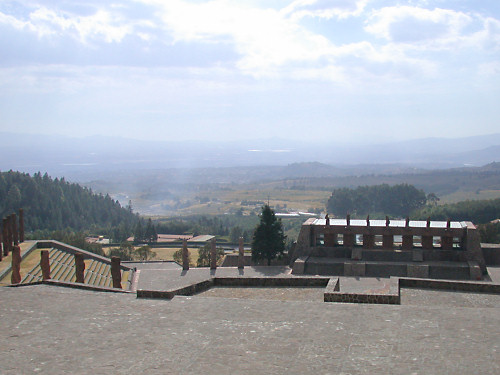 View over the air-polluted Toluca Valley from the Otomi
center
View over the air-polluted Toluca Valley from the Otomi
center
Coming from Holland, the way Toluca and the surrounding valley are organized is
quite a contrast. Toluca is very close to Mexico City, and many global
(chemical) companies have facilities here. Many people find work here, and as a
result the Toluca valley is filled up with towns and houses, often joined to
form large areas of housing, open sewers, rubbish dumps, etc., on a scale that
is rather depressing. The commuting traffic is horrendous. Leaving and entering
Toluca takes about 1 to 1,5 hours, and outside Toluca the traffic flow is
seriously hampered by the many "topas" or speed bumps that can only be passed
with speeds close to zero. As a result, some birding areas from the Howard book
(central Mexico, chapter 8) were simply out of reach.
On the way from Toluca to Temascaltepec you pass a small roadside pond. A short
stop on 10-3 produced Ruddy Duck 30,
Mallard 2 domesticated birds,
Black Phoebe 2,
American Pipit 1.
On 12-3-2008 I joined Tineke who went to work at The CIRA-UEAM Institute
(http://cira.uaemex.mx/)
just outside Toluca. The road leading to the institute, highway 55, passes a
small and rather polluted lake. We made a short stop there. The number of
Northern Shovelers was impressive. I counted
16.000 birds! Other birds there included Great
Egret, Cattle Egret,
Eared Grebe 4,
Northern Pintail 20,
Blue-winged Teal 40,
American Wigeon 200,
Canvasback 1 female,
Ring-necked Duck 20,
Ruddy Duck 800,
Black-necked Stilt 2,
Wilson's Phalarope 4 winter plumage,
American Kestrel,
Common Moorhen,
American Coot,
Killdeer.
In the afternoon we paid a visit to the Otomi Ceremonial Center in the mountains
just outside of Toluca. This complex is of recent times (1975), built in tribute
of the Otomi people, and is used for ceremonies and festivities. Also, the
Toluca soccer team prepares for games there. The location is beautiful,
overlooking the Toluca valley with the Toluca Volcano present in the background.
The Lerma Marshes were also visible. On the complex we saw
Bushtit 6, Black
Phoebe and Yellow-eyed
Junco >100. When the complex closed at 17:00 hours, we decided to
drive further up in the mountains. We soon reached the mountaintop. On a saddle
point we came across a large field, with a herd of cows and accompanying
cowboys. The field was literally covered with Eastern
Bluebirds. We decided to check out the forest edge. While I was
following a warbler, Tineke called me to check out a woodpecker. Before I could
find the bird, it flew to a small group of fir trees further down the field. It
called several times in flight. I already had a suspicion about the identity,
and hurried towards this group of trees. And sure enough, here we had splendid
views of a pair of Strickland's Woodpecker
feeding on the upper branches of the trees. This species only occurs on the
volcanic belt in D.F., and was one of the species I really wanted to see. While
driving through the mountains back to Toluca, we repeatedly heard the song of
Brown-backed Solitaire coming through the
windows.
Cerro San Felipe
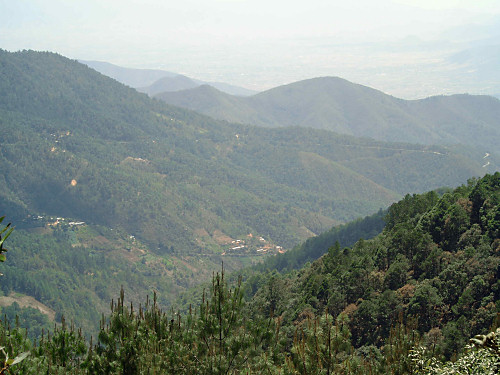 The forest at Cerro San Felipe, with the Oaxaca
Valley in the background
The forest at Cerro San Felipe, with the Oaxaca
Valley in the background
On 16-3, our first day in Oaxaca, we went into the mountains to try to find the
Dwarf Jay (amongst others). Having paid the entrance fee, we drove 2 km down the
track and then continued by foot. After 1 km we descended the well-known track
down into the forest. After approximately 1 km, where a small stream crosses the
track, I saw a flash of a Dwarf Jay coming
down and disappearing in a dense tree. The bird was quickly followed by another
one. We waited a few minutes and suddenly both birds appeared again, calling a
few times while flying further down into the valley. We couldn't relocate them.
Sound and silhouette were unmistakable but I would have liked to see the birds a
little bit better.
Other birds seen on our visit: Black
Vulture, Turkey Vulture,
Red-tailed Hawk 1,
Mountain Pygmy-Owl 1 heard,
Mountain Trogon 4 singing (2 also seen very
well), Spot-crowned Woodcreeper,
Violet-green Swallow,
Dwarf Jay 2,
Steller's Jay,
Northern Raven 2,
Mexican Chickadee,
Brown Creeper,
Brown-backed Solitaire 5 singing,
Russet Nightingale-Thrush 2 (1 very
confiding bird on the track), Grey Silky,
Hutton's Vireo,
Golden Vireo 1,
Crescent-chested Warbler 5 singing (3 seen
well), Townsend's Warbler 2,
Hermit Warbler 2,
Yellow-eyed Junco,
Red Warbler 8,
Slate-throated Whitestart 15.
Santa María del Tule
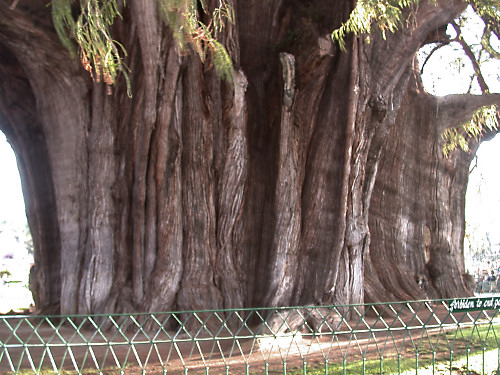 Impressive trunk of the Tule Montezuma
Cypress
Impressive trunk of the Tule Montezuma
Cypress
In the afternoon of 16-3, we went to Tule to see "El Árbol del Tule", a famous,
giant and about 1,500-year-old Montezuma Cypress. On the way we had
Crested Caracara 1 flying and 4 sitting
together in the corner of a field, and a Peregrine
Falcon passing with prey over the Tule town. On the way back to
Oaxaca we passed a Great-tailed Grackle
roosting site of over 100 birds.
Highway 175/Black Tank
I visited the "Black Tank" area several times. The area is described in the
Howell book on bird finding. It is located along highway 175, just past the
reservoir and where the road enters the mountains. A dumped oil tank amongst a
lot of other debris marks the precise location. Not a spot that Tineke favored.
I tried to find Oaxaca Sparrow here (but didn't succeed). However, I had another
success. On 16-3 I had short views of the tail of a
Lesser Roadrunner, sticking in the air while
the bird was hiding under a bush. The tail disappeared before I could get a
proper look at the bird, and I could not relocate the bird. When we revisited
the area on 21-3, returning from Valle Nacional, I again stumbled on a Lesser
Roadrunner at almost the same spot. This time the bird was sitting on a ledge
and I got a good view of the whole bird. In a split second it vanished again.
The view was too short to distinguish the bird from Greater Roadrunner, but that
species doesn't occur here.
Other birds seen at this location: 16-3: Cassin's
Kingbird 5, Rufous-capped Warbler
2, Colima Warbler 2. 19-3:
Blue-hooded Euphonia: 1 male singing in
mistletoe, Bridled Sparrow 2,
Rufous-capped Warbler 1.
21-3: Ash-throated Flycatcher 1.
Teotitlán del Valle
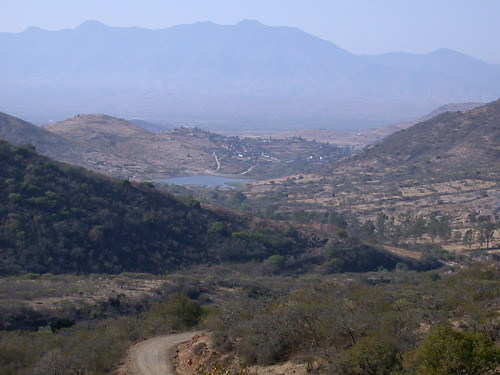
Looking down from the hills above Teotitlán, reservoir
in the background
On 17-3 we went to Teotitlán from early morning to early afternoon. First be
birded shortly at the reservoir. Being one of the few places with open water, it
held a lot of species that are uncommon for Oaxaca:
Least Grebe 30,
Great Egret 1,
Snowy Egret 2,
Cattle Egret 2,
Blue-winged Teal 30,
Ruddy Duck 30,
American Coot 40,
Killdeer, Spotted
Sandpiper 4, Least Sandpiper 40,
Dusky Hummingbird 10 (feeding at the outflow
of the reservoir), Black Phoebe 2,
Vermilion Flycatcher,
Violet-green Swallow,
Northern Rough-winged Swallow,
American Pipit 1,
Chipping Sparrow.
Soon after inspection of the reservoir, we went further up the road and tried to
find birds at the foot of the mountains. This produced the following birds:
Turkey Vulture,
Red-tailed Hawk 2,
White-winged Dove,
Inca Dove,
White-tipped Dove 1,
Mourning Dove,
Nutting's Flycatcher,
Cassin's Kingbird,
Thick-billed Kingbird,
Western Scrub Jay,
Bewick's Wren,
Blue-grey Gnatcatcher,
Northern Mockingbird 1,
Curve-billed Thrasher 4,
Grey Silky,
Wilson's Warbler,
Rufous-capped Warbler,
Black-headed Grosbeak,
White-throated Towhee 8,
Bridled Sparrow 1,
Black-vented Oriole 1.
On 22-3, our last day in Oaxaca, I decided to do a last attempt at seeing some
Oaxaca endemic at Teotitlán. However, it was very quiet, searching birds was
hard work and produced nothing new. I managed to find 8
Bridled Sparrows, but not one Oaxaca
Sparrow. No vireo song to be heard. Bewick's
Wren 10, Grey Silky 4,
White-throated Towhee >10,
Rufous-sided Towhee 1,
Western Scrub Jay 2,
Black-headed Grosbeak several singing males,
Bronzed Cowbirds 6.
Yagul
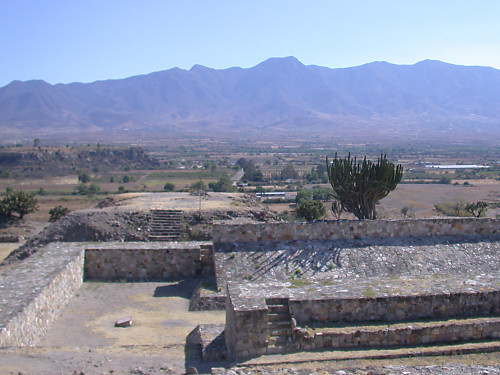
View on Oaxaca Valley from Yagul, with the "ball court"
on the foreground
In the afternoon of 17-3 we went to Yagul, to visit the ruins and do some late
afternoon birding. The ruins were nice and peaceful. Around the ruins we found
the following birds: Black Vulture,
Turkey Vulture,
White-tailed Kite 1,
Sharp-shinned Hawk,
Red-tailed Hawk,
Crested Caracara 5,
American Kestrel 1,
White-winged Dove 6,
Say's Phoebe 2,
Vermilion Flycatcher,
Rock Wren 2,
Bewick's Wren 2,
Northern Mockingbird 1,
Curve-billed Thrasher 2,
White-throated Towhee 4,
Lark Sparrow 1,
House Finch 40. On the way back to Oaxaca we
had another (or the same?) White-tailed Kite.
Monte Alban
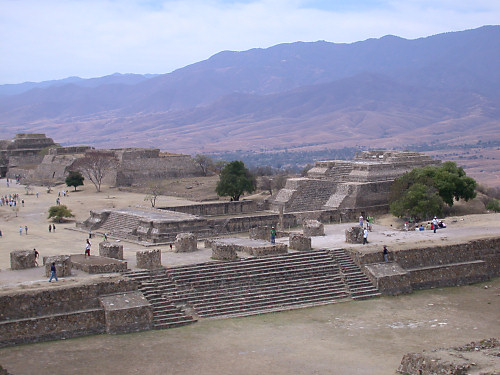 Part of the Monte Alban complex and the surrounding
valley
Part of the Monte Alban complex and the surrounding
valley
On 18-3 we went to Monte Alban, to first do some birding around the parking lot
and then visit the ruins. Birding turned out to be a disappointment. First he
road was fenced off >1 km from the parking lot. We had to walk for over 20
minutes and back again to pick up the car. The parking lot around tomb 107 seems
to hold only common species. I could not discover any species that would be new
for this trip. Especially the Dwarf Vireo, Slaty Vireo and Oscalated Thrasher
were nowhere to be found. Birds we did see:
Ladder-backed Woodpecker 1 female,
Cassin's Kingbird,
Violet-green Swallow,
Canyon Wren 2 (nestling in Tomb 107),
White-throated Towhee 10,
Dusky Hummingbird 1,
Black-vented Oriole,
House Finch 50,
Lesser Goldfinch 5. From the ruins we saw
Crested Caracara 1 passing,
Rock Wren 3 on the ruins.
Valle Nacional
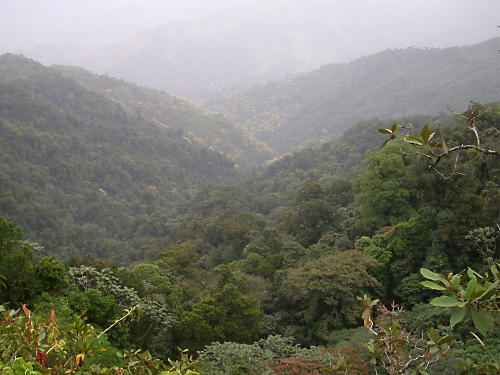 Birding the cloud forest at Valle
Nacional
Birding the cloud forest at Valle
Nacional
On 19-3 we went from Oaxaca to Valle Nacional, for a two-day stay. The road was
is good condition. No potholes of importance, but many windings, especially in
the descent from the mirador to Valle Nacional. There was not much traffic on
the road. The weather forecast indicated a clouded day, and a drop in
temperature. And sure enough, shortly after crossing the mountain ridge at the
mirador we drove into the clouds and mist. The moist formed a continuous rain
coming from the vegetation. Occasionally, the clouds opened up somewhat and gave
us splendid views on the cloud forest. When approaching Valle Nacional, a light
rain was falling. We stopped at Esperanza to scan the forest from a view point
just below the village, and the result was stunning:
Plain Chachalaca 4 heard (brief views of
birds descending the slope), Aztec Parakeet
2, Bumblebee Hummingbird 4,
Emerald Toucanet 2 (heard, 1 seen),
Social Flycatcher 4,
Masked Tityra 1,
Brown Jay 4,
Unicolored Jay 8,
Southern House Wren 1,
Slate-colored Solitaire 10 heard,
Clay-colored Thrush 4,
White-throated Thrush 1,
Crescent-chested Warbler 1,
Black-and-white Warbler 1,
Slate-throated Whitestart 1,
Yellow-winged Tanager 10,
Common Bush-Tanager 1,
Buff-throated Saltator 1,
Black-headed Grosbeak 1,
White-collared Seedeater 2. Simply
wonderful.
The lower section of the road to Valle Nacional, near Yetla, produced the
following: Turkey Vulture,
Red-billed Pigeon 2,
White-faced Quail-Dove 4 heard, Couch's or
Tropical Kingbird 2, Brown Jay 2,
Blue-grey Gnatcatcher 2,
Blue-grey Tanager 1,
Yellow-winged Tanager 2,
Indigo Bunting 3,
Great-tailed Grackle,
Chestnut-headed Oropendola 8 (gathering in a
tree top).
On 20-3 we again went to the lookout point just below Esperanza. This time we
saw and heard: Turkey Vulture,
White-faced Quail-Dove heard,
Pheasant Cuckoo 2+1 singing,
Collared Trogon several singing, 1 seen very
well, Golden-olive Woodpecker 1,
Unicolored Jay 2,
Slate-colored Solitaire 6 heard and 1 seen,
Blue-hooded Euphonia 1 singing,
Common Bush-Tanager >10,
Yellow-faced Grassquit 1 at the chapel along
the road, Bronzed Cowbird 6 in Esperanza,
Yellow-winged Tanager 10.
In the afternoon we birded in the lowlands, at both sides of Valle Nacional. A
small track leading to and along the river just above San Mateo Yetla and ending
at some clear-cut fields produced some nice species.
Neotropic Cormorant 1 + 3,
Cattle Egret 30,
Green Heron 1,
Black Vulture 60,
Grey Hawk 2 birds perched and calling to
each other at dusk, Double-toothed Kite 1
flying, Common Black Hawk 1 with prey
(reptile), Spotted Sandpiper 1,
Aztec Parakeet 20,
White-collared Swift 30,
Long-tailed Hermit 2,
Black-crested Coquette 1 male,
Canivet's Emerald 2 male plus females,
Bumblebee Hummingbird 1 male,
Ringed Kingfisher 2,
Golden-fronted Woodpecker 3,
Greater Pewee 1,
Black Phoebe 3,
Social Flycatcher 10,
Northern Rough-winged Swallow,
Brown Jay 6,
Southern House Wren 1,
Blue-grey Gnatcatcher,
Clay-colored Thrush 3,
Crescent-chested Warbler 1,
Black-throated Green Warbler 1,
Black-and-white Warbler 1,
Wilson's Warbler 2,
Bananaquit 2,
Black-headed Grosbeak 6,
White-collared Seedeater 5,
Bronzed Cowbird 15,
Great-tailed Grackle >100,
Baltimore Oriole 1,
Montezuma Oropendola 6 and several singing
in a colony of 7 nests.
We also saw an Oriole that I assume to be a Baltimore Oriole. The light-colored
and straight bill with a dark spot on the lower mandible matches only with
Baltimore Oriole. The plumage however doesn't really fit any picture or
description I've come across. I would appreciate it if someone who recognizes
this plumage can shed some light on this.
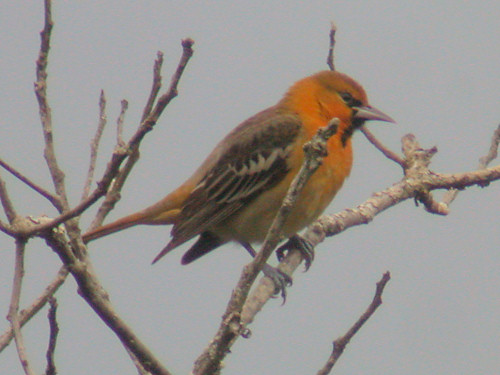 Presumably an immature male Baltimore Oriole, any
additional info is welcome.
Presumably an immature male Baltimore Oriole, any
additional info is welcome.
Finally, on our way back to Oaxaca on 21-3, we stopped again at the lowlands
just above the town of Yetla. Again we saw several new and fine species.
Neotropic Cormorant 3,
Little Blue Heron 1,
Turkey Vulture,
White Hawk 1 flying together with 3 Turkey
Vultures, Spotted Sandpiper 1,
Red-billed Pigeon 1 at the hotel,
Aztec Parakeet 6,
White-collared Swift 4,
Ringed Kingfisher 1,
Golden-fronted Woodpecker 1,
Barred Woodcreeper 1,
Social Flycatcher 2,
Brown Jay 4,
Plumbeous Vireo 1,
Ovenbird 1,
Bananaquit 1, Flame-colored
Tanager 1 male and 1 female, Black-headed
Saltator 1, Melodious Blackbird
2, Montezuma Oropendola 1 singing.
At Esperanza we had: Double-toothed Kite 1,
Pheasant Cuckoo 1 singing,
Emerald Toucanet 1,
Brown Jay 6,
Slate-colored Solitaire 4 including 1 in
song flight. Two distant Amazon parrots couldn't be identified.
The mirador at the mountain ridge held two surprises:
Grey-barred Wren 4 noisy birds crossing the
ridge and Cinnamon-bellied Flowerpiercer 2
singing and feeding males. Also Northern
Raven 2.
A short stop in the dry interior valley between the mirador en Cerro San Felipe
produced MacGillivray's Warbler 1,
Veery 1 (only by Tineke),
Blue-throated Hummingbird 1.
Oaxaca - Puebla
On 22-3 we left Oaxaca to return to Mexico City. We took the cuota that cuts
through some beautiful landscapes. From Oaxaca you first pass a mountain range
and than enter a valley at 1200 m. The hillsides are covered with large column
cacti. We pulled out at the first possible location that offered close views on
the cacti. I scanned the cacti and within 10 seconds I had my first
Grey-breasted Woodpecker! After the valley
with cacti came a valley at 1800 m with Yuccas that strongly resemble the
beautiful Joshua-trees. When stopping for a tollbooth, we discovered two
splendid adult White-tailed Hawks passing
the highway. The rest of the trip was uneventful. We wanted to visit the area
described by Howell under "8-7 Laguna San Felipe", so we left the toll way at
Puebla and ended up in Atlixco.
Tlacotepec
On the last day in Mexico, 23-3, we had to spend a morning in the vicinity of
Mexico City. We decided to do the area that is described under "8-7 Laguna San
Felipe", but is actually a small mountain range at some 50 km distance from the
Laguna. It was Eastern, so we came across a lot of preparation for Eastern
festivities. The mountain area itself however was peaceful, and the scenery was
beautiful. We had very close views to White-naped
Swifts, also seen from above. Although the area seems to be more
cultivated then described in the Howell-book, we found some nice birds,
including a splendid male Blue-throated
Hummingbird, a passing immature Broad-winged
Hawk and a female Blue-hooded
Euphonia hiding in a bunch of mistletoe. In the surrounding fields
Loggerhead Shrike was common. However, I
found it hard to really focus on birding. The evening before, electronic
confirmation of our e-tickets had failed. We had to arrive at least 3 hours
before departure to settle things or risk loosing out airplane seats. And we
still had to drive to and through Mexico City. We decided to play it safe and
leave early.
Full species list
We have observed 210 bird species. They are listed here, with endemics species
(29) marked in bold.
Although I focused on observing birds, I also took some bird pictures using the
digiscoping technique (Nikon Coolpix 995 digital compact camera through a
Swarovski AT 80 HD telescope). Some photos were helpful in identifying the
species (Spotted Wren, Summer Tanager). I had sound recordings with me, which
helped (especially in the Valle Nacional area) to identify species that were
very vocal but not visible (Great Chachalaca, Pheasant Cuckoo, White-fronted
Quail-Dove, Spot-breasted Wren).
-
Least Grebe - 17-3 and 22-3: 30 birds in the reservoir above Teotitlán
-
Pied-billed Grebe - on most ponds and marshes in D.F.
-
Eared Grebe - 12-3: 4 in lake along highway 55 Toluca-Atlacomulco, 14-3:
some 50 on the Lerma Marshes
-
Brown Pelican - 14-3: 1 immature bird on a fish tank in the Lerma Marshes
(much to my surprise)
-
Neotropic Cormorant - 20-3 and 21-3: several birds present on the river just
above Valle Nacional
-
Great Blue Heron - 9-3 and 14-3: common at Lerma Marshes
-
Great Egret - 9-3 and 14-3: common at Lerma Marshes, also seen on smaller
lakes and ponds, 17-3: 1 bird at Teotitlán.
-
Snowy Egret - 9-3 and 14-3: common on Lerma Marshes, 17-3: 2 birds at
Teotitlán
-
Little Blue Heron - 21-3: 1 present on the river just above Valle Nacional
-
Cattle Egret - seen every day, very common in agricultural areas and around
open sewers
-
Green Heron - 20 and 21-3: 1 present on the river just above Valle Nacional
-
Black-crowned Night-Heron - 9-3: 8 at Lerma Marshes flying around at dusk
-
White-faced Ibis - 9-3 and 14-3: some 100 birds present in Lerma Marshes
-
Green-winged Teal - 9-3 and 14-3: common in Lerma Marshes, also on smaller
ponds in D.F.
-
Northern Pintail - 12-3: several birds the pond along highway 55, 14-3:
present in the Lerma Marshes
-
Blue-winged Teal - 9-3 and 14-3: common in Lerma Marshes, also on small
ponds in D.F., 16-3 and 22-3: 30 in the reservoir above Teotitlán
-
Cinnamon Teal - 14-3: 4 at Lerma Marshes
-
Northern Shoveler - 12-3: 16,000 along highway 55 Toluca-Atlacomulco, 14-3:
3,400 in the Lerma Marshes
-
Gadwall - 14-3: 4 at Lerma Marshes
-
American Wigeon - 9-3 and 14-3: present in the Lerma Marshes, 12-3: hundreds
in the pond along highway 55
-
Canvasback - 12-3: 1 female in pond along highway 55 Toluca-Atlacomulco
-
Ring-necked Duck - 9-3 and 14-3: common in Lerma Marshes, also on small
ponds in D.F., 16-3: 1 at Teotitlán
-
Ruddy Duck - 12-3: 800 in the pond along highway 55, 14-3: 1600 in the Lerma
Marshes, 16-3: 30 at the reservoir above Teotitlán.
-
Black Vulture - Seen every day in low numbers, 20-3: 50 perched and on the
ground in the lowlands at Valle Nacional. Here we saw small groups attending
gardens and towns, undisturbed by the presence of people.
-
Turkey Vulture - Seen every day in low numbers, maximum on 17-3: a group of
9 at Yagul.
-
Grey Hawk - 21-3: 2 birds perched in the lowland forest at Valle Nacional.
At dusk they started calling to each other.
-
White-tailed Kite - 17-3: 1 at Yagul, and 1 (possibly the same bird) on the
way back to Oaxaca
-
Double-toothed Kite - 20-3 and 21-3: 1 flying at Valle Nacional lowland
-
Northern Harrier - 8-3 and 14-3: common at Lerma Marshes, 4 seen at the same
time
-
Sharp-shinned Hawk - 8-3: 1 at Lerma Marshes, 11-3: 1 at Coajamulco, 17-3: 1
at Yagul
-
White Hawk - 21-3: 1 soaring together with 3 Turkey Vultures just above
Valle Nacional
-
Common Black Hawk - 20-3: 1 with prey at (reptile) just above Valle Nacional
-
Broad-winged Hawk - 1 immature near Tlacotepec (23-3)
-
White-tailed Hawk - 22-3: 2 adults flying over the Oaxaca - Puebla cuota
-
Red-tailed Hawk - single birds seen at almost every site, 11-3: 1 dark phase
at Coajamulco
-
Crested Caracara - only seen in the direct vicinity of Oaxaca, 16-3: 4 on
the ground, 1 flying near Santa María del Tule, 17-3: 5 soaring at Yagul,
18-3: 1 flying past at Monte Alban
-
American Kestrel - single birds seen at almost every site
-
Peregrine Falcon - 16-3: 1 with prey over Santa María del Tule
-
Plain Chachalaca - 19-3: 4 heard (very noisy) and brief flashes seen while
they descended the slopes at the cloud forest near Esperanza
-
Sora - 14-3: 2 at close range at Lerma Marshes
-
Common Moorhen - Very common al all kind of ponds in Central Mexico.
Especially large numbers in ditches around the Lerma Marshes
-
American Coot - Common on all larger ponds and marshes in Central Mexico.
Also present on the reservoir near Teotitlán
-
Killdeer - 8-3: present in small numbers around the Lerma Marshes, 12-3:
around pond along highway 55, 17-3: 1 at the reservoir near Teotitlán
-
Black-necked Stilt - 12-3: 2 at pond along highway 55, 14-3: 4 at Lerma
Marshes
-
American Avocet - 14-3: a group of 60 at Lerma Marshes
-
Greater Yellowlegs - 8-3: 4 at Lerma Marshes
-
Spotted Sandpiper - 14-3: 2 at Lerma Marshes, 17-3: 4 at the reservoir near
Teotitlán, 20-3: 1 along the river near Yetla
-
Least Sandpiper - 8-3 and 14-3: 20 at Lerma Marshes, 17-3: 40 at the
reservoir near Teotitlán
-
Long-billed Dowitcher - 8-3: 20 at Lerma Marshes
-
Common Snipe - 8-3: 2 at Lerma Marshes
-
Wilson's Phalarope - 12-3: 4 at pond along highway 55, 14-3: 8 at Lerma
Marshes (all in winter plumage)
-
Laughing Gull - 8-3 and 14-3: 1 adult winter plumage at Lerma Marshes
-
Red-billed Pigeon - 19-3: 2 at Valle Nacional, 21-3: 1 at the hotel in Valle
Nacional
-
White-winged Dove - Common around Oaxaca
-
Mourning Dove - 8-3: several at Lerma Marshes, 17-3: several heard at
Teotitlán
-
Inca Dove - Common in Toluca and surroundings, and around Oaxaca
-
White-tipped Dove - 17-3: 1 at close range on the ground, in the hills above
Teotitlán
-
White-faced Quail-Dove - 19-3 and 20-3: several
birds heard at Valle Nacional lowland (after careful comparison with sound
recordings of this species and Ruddy Quail-Dove. The latter has a quite
similar call, but I've not heard it with certainty).
-
Aztec Parakeet - 19-3: 2 near Esperanza, 20-3: 20 above Valle Nacional
-
Pheasant Cuckoo - only heard, on 20-3: first 2 birds pair singing, later a
single bird heard, 21-3: 1 bird singing
-
Lesser Roadrunner - 16-3: short view of
only a tail at Highway 175/Black Tank area. On 21-3: short but better view
of a bird at the same location.
-
Groove-billed Ani - 10-3: 1 at Temascaltepec
-
Mountain Pygmy-Owl - 16-3: 1 calling at Cerro San Felipe
-
Short-eared Owl - 8-3: 1 flying around at dusk with prey (mouse) in it's
legs
-
White-collared Swift - 20-3: 30 at Valle Nacional, 21-4: another 4 at same
location
-
White-naped Swift - 23-3: several flying
around near Tlacotepec, close views from above.
-
Vaux's Swift - 10-3: >100 at Temascaltepec
-
Long-tailed Hermit - 20-3: 2 in lowlands at Valle Nacional
-
Black-crested Coquette 20-3: 1 male in lowlands at Valle Nacional
-
Canivet's Emerald - 20-3: 2 males and
several females in lowlands at Valle Nacional
-
Dusky Hummingbird - 17-3: 10 feeding from
flowering trees at the outflow of the reservoir near Teotitlán, 18-3:
1 at Monte Alban
-
White-eared Hummingbird - 11-3: 10 at
Coajamulco, 13-3: several at Temascaltepec
-
Berylline Hummingbird -
10-3: >20 at Temascaltepec, 10-3: several at
same location
-
Blue-throated Hummingbird - 2-3: 1 at dry interior valley between Valle
Nacional and Oaxaca, 23-3: 1 splendid male at Tlacotepec
-
Broad-tailed Hummingbird -
10-3: 1 male at Temascaltepec
-
Rufous Hummingbird - 9-3: 1 male at foot of Toluca Volcano
-
Bumblebee Hummingbird - 19-3: 4 in cloud forest
near Esperanza, 20-3: 1 male in lowlands near Valle
Nacional
-
Mountain Trogon -16-3: 4 singing at Cerro San
Felipe, 2 seen very well, including the distinctive undertail
pattern
-
Collared Trogon - 20-3: several singing in cloud forest near Esperanza, 1
seen very well
-
Ringed Kingfisher - 20-3: 2 at the river near Yetla, 21-3: 1 at the same
location
-
Green Kingfisher - 13-3: 1 at Temascaltepec, discovered by Tineke
-
Emerald Toucanet - 19-3: 2 heard, 1 shortly seen, at Esperanza, 21-3: 1 at
same location
-
Acorn Woodpecker - 10-3: 2 above the forest at Temascaltepec, 11-3: 1 at
Coajamulco, 13-3: 1 near Temascaltepec
-
Grey-breasted Woodpecker - 22-3: 1 in a cactus along the Oaxaca-Puabla cuota
-
Golden-fronted Woodpecker - Common and conspicuous in lowlands around Valle
Nacional, 20-3: 3 seen, 21-3: 1 seen.
-
Ladder-backed Woodpecker - 10-3: 1 female at Temascaltepec, 18-3: 1 female
at Monte Alban
-
Strickland's Woodpecker - 12-3: a pair in the
mountains above Otomi Ceremonial Center, discovered by
Tineke
-
Golden-olive Woodpecker - 20-3: 1 showing very well in the cloud forest at
Esperanza
-
Northern Flicker - 10-3 several heard and seen at Toluca Volcano, also on
11-3 at La Cima
-
Barred Woodcreeper - 21-3: 1 in the lowlands above Valle Nacional.
-
Spot-crowned Woodcreeper - 16-3: close and long views on a sneaky bird, that
often assumed a frozen position amongst thick branches and then was
almost invisible
-
Tufted Flycatcher - 10-3: 2 at Temascaltepec
-
Greater Pewee - 11-3: 1 at La Cima, 20-3: 1 at Esperanza
-
Buff-breasted Flycatcher - 8-3: 1 at Lerma Marshes, 11-3: 1 at Coajamulco
-
Black Phoebe - common along all sorts of open water
-
Say's Phoebe - 8-3: present at Lerma Marshes, 11-3: present at Coajamulco,
17-3: 2 at Yagul
-
Vermilion Flycatcher - common in half open landscapes, such as fields,
gardens, etc.
-
Ash-throated Flycatcher - 16-3: 1 along highway 175 from Oaxaca, Black Tank
area
-
Nutting's Flycatcher - 17-3: common above Teotitlán
-
Social Flycatcher - common in lowland forest above Valle Nacional
-
Cassin's Kingbird - 14-3: present in Lerma Marshes. Also seen in almost all
locations around Oaxaca.
-
Thick-billed Kingbird - 10-3: present around Temascaltepec, 17-3: present
above Teotitlán
-
Masked Tityra - 19-3: 1 in a group of Yellow-winged Tanagers at Esperanza
-
Violet-green Swallow - common in all mountainous areas
-
Northern Rough-winged Swallow - common around open water
-
Barn Swallow - 8-3: common in the Lerma Marshes
-
Steller's Jay - 11-3: 10 at La Cima and 4 at Coajamulco, 16-3: present in
Cerro San Felipe
-
Brown Jay - common and noisy in lowlands above Valle Nacional, on 21-3: 6
seen
-
Dwarf Jay - 16-3: 2 at Cerro San Felipe,
short flight views plus call heard
-
Western Scrub Jay - 17-3 and 22-3: several birds in Teotitlán
-
Unicolored Jay - common in cloud forest above
Valle Nacional, on 19-3: 8 seen
-
Northern Raven - 11-3: 1 at Coajamulco, 16-3: 2 at Cerro San Felipe, 21-3: 2
at the mirador along highway 175
-
Mexican Chickadee - 9-3 and 10-3: several at Toluca Volcano, 16-3: present
in Cerro San Felipe
-
Bridled Titmouse - 13-3: 2 at Temascaltepec
-
Bushtit - 11-3: 2 at La Cima, 12-3: 6 at Otomi Ceremonial Center
-
White-breasted Nuthatch - 11-3: 2 at La Cima
-
Pygmy Nuthatch - 10-3: 2 at Toluca Volcano
-
Brown Creeper - 10-3: 4 at Toluca Volcano, 16-3: several in Cerro San
Felipe.
-
Grey-barred Wren - 21-3: 4 noisy birds crossing
the mountain ridge at the mirador along highway 175 between Oaxaca and Valle
Nacional
-
Spotted Wren - 10-3: 1 at Temascaltepec,
feeding on insects on an electricity pole just above the forest.
-
Rock Wren - 17-3: 2 at Yagul, 18-3: 3 at Monte Alban
-
Canyon Wren - 10-3: 1 heard at Real de Arriba near Temascaltepec, 13-3: 1
singing on a roof above Temascaltepec, 18-3: 2 birds bringing nest material
into tomb 107
-
Spot-breasted Wren - 20 and 21-3: several birds heard in the forest above
Valle Nacional
-
Happy Wren - 13-3: 1 at Temascaltepec
-
Bewick's Wren - 9-3: 1 at Toluca Volcano, 17-3 common at Teotitlán, 22-3: 10
at same location, 17-3: 2 at Yagul
-
Brown-throated Wren - 11-3: 1 at Coajamulco
-
Southern House Wren - 19 and 20-3: 1 at Valle Nacional
-
Marsh Wren - 14-3: 1 at Lerma Marshes
-
Ruby-crowned Kinglet - 13-3: 1 at Temascaltepec
-
Blue-grey Gnatcatcher - 17-3: 2 at outflow of reservoir above Teotitlán, 19
and 20-3: 2 birds in the lowlands above Valle Nacional
-
Eastern Bluebird - very common, especially in clear cuts and fields in
mountainous forests, 12-3: >50 on the mountain above the Otomi Ceremonial
Center
-
Brown-backed Solitaire - common in
mountainous forest in D.F. Very striking song could be heard at any time of
the day. 11-3 learned the song at Coajamulco, 12-3: >5 heard in the
mountains above the Otomi Ceremonial Center, 16-3: 5 heard at Cerro San
Felipe
-
Slate-colored Solitaire - common in
cloud forest above Valle Nacional, song heard all day, 19-3: 10 heard, 20-3:
1 singing in top of tree, 21-3: 1 singing in flycatcher-like flight
-
Russet Nightingale-Thrush - 16-3: 2 birds at
Cerro San Felipe, 1 confiding bird that feeded on the track and came
in very close range
-
Veery - 21-3: 1 bird seen by Tineke at the river running through the dry
interior valley between Oaxaca and Valle Nacional
-
Clay-colored Thrush - 19-3: 4 birds at Esperanza, 20-3: 3 birds in the
lowlands at Yetla, also 1 bird present near the hotel in Valle Nacional.
-
White-throated Thrush - 19-3: 1 bird amongst Clay-colored Thrushes at
Esperanza.
-
American Robin - common on fields outside the rural areas in D.F.
-
Northern Mockingbird - 17-3: 1 at Teotitlán and 1 at Yagul, both singing.
-
Curve-billed Thrasher - 10-3: 3 birds above the forest at Temascaltepec,
17-3: 4 birds at Teotitlán and 2 birds at Yagul
-
American Pipit - 8-3: 1 at Lerma Marshes, 10-3: 1 at a pond just outside
Toluca towards Temascaltepec, 17-3: 1 at Teotitlán
-
Grey Silky - Common in almost all
mountainous woods in D.F. and Oaxaca. On 11-3 I discovered a pair at a nest
location at Coajamulco.
-
Loggerhead Shrike - 9-3: 1 with small mouse at Lerma Marshes, 23-3: >4 in
the area around Tlacotepec
-
Plumbeous Vireo - 21-3: 1 in lowlands near Yetla
-
Hutton's Vireo - 16-3: 1 at Cerro San Felipe
-
Golden Vireo - 16-3: 1 at Cerro San
Felipe
-
Orange-crowned Warbler - 11-3: 1 at Coajamulco.
-
Colima Warbler - 16-3: 2 at Highway 175/Black Tank area.
-
Nashville Warbler - 10-3: 1 at Temascaltepec
-
Crescent-chested Warbler - 16-3: 5 at
Cerro San Felipe, 19 and 20-3: 1 at Valle Nacional
-
Audubon's Warbler - 11-3: 1 at La Cima and 2 at Coajamulco
-
Black-throated Grey Warbler - 10-3: 1 at Temascaltepec
-
Townsend's Warbler - 13-3: 1 at Temascaltepec, 16-3: 2 at Cerro San Felipe
-
Hermit Warbler - 16-3: 2 at Cerro San Felipe
-
Black-throated Green Warbler - 20-3: 1 in lowlands above Valle Nacional
-
Black-and-white Warbler - 19 and 21-3: 1 in lowlands above Valle Nacional
-
Ovenbird - 21-3: 1 near river at Yetla
-
Northern Waterthrush - 8-3: 1 at Lerma Marshes
-
MacGillivray's Warbler - 10-3: 1 at Temascaltepec, 21-3: 1 in dry interior
valley between Oaxaca and Valle Nacional
-
Common Yellowthroat - 9-3 and 14-3: >40 at Lerma Marshes
-
Black-polled Yellowthroat - 9-3 and 14-3:
>10 at Lerma Marshes
-
Wilson's Warbler - This was the most prominent bird of this trip. I saw a
few birds in almost every area that I visited, from dry bushes in D.F. to
the cloud forest in Valle Nacional. It was even present in the patio of our
Oaxaca apartment, checking the flowering plants hanging from the balconies.
-
Red Warbler - 9-3 and 10-3: several birds at
Toluca Volcano, 16-3: 8 at Cerro San Felipe
-
Slate-throated Whitestart - 11-3: 3 at La Cima and 1 at Coajamulco, 16-4: 15
at Cerro San Felipe, 19-3: 1 at Esperanza
-
Rufous-capped Warbler - 10-3: 2 at Temascaltepec, 16-3: 2 at Highway
175/Black Tank area, 19-3: 1 at same location, 17-3: 1 at Teotitlán
-
Olive Warbler - 11-3: 1 male and 1 female at Coajamulco
-
Bananaquit - 20-3: 2 at Esperanza, 21-2: 1 near Yetla
-
Blue-hooded Euphonia - 19-3: 1 male singing at Oaxaca, highway 175 at the
Black Tank location, 23-3: 1 female hiding in mistletoe near Tlacotepec.
-
Blue-grey Tanager - 19-3: 1 between Yellow-winged Tanagers in lowland near
Yetla
-
Yellow-winged Tanager - common and conspicuous
around Esperanza, 19 and 20-3: 10 seen there
-
Hepatic Tanager - 13-3: 1 female at Temascaltepec
-
Summer Tanager - 11-3: 1 female at Coajamulco
-
Flame-colored Tanager - 21-3: 1 male and 1 female in the lowlands near Yetla
-
Common Bush-Tanager - 19-3: 1 at Esperanza, 20-3: >10 at Esperanza
-
Buff-throated Saltator - 19-3: 1 at Esperanza
-
Black-headed Saltator - 21-3: 1 in lowlands near Yetla
-
Black-headed Grosbeak - 10-3: 1 at Temascaltepec, 17-3 and 22-3: several
singing males in the mountains above Teotitlán, 19-3: 1 at Esperanza, 20-3:
6 at Yetla
-
Indigo Bunting - 10-3: 8 in fields above Temascaltepec, 19-3: 3 near Yetla
-
Varied Bunting - 10-3: 1 near Temascaltepec
-
Rufous-capped Brushfinch - 11-3: 1 skulking
bird at La Cima
-
Rufous-sided Towhee - 11-3: 1 in the mountains between La Cima and Toluca,
22-3: 1 near Teotitlán
-
Canyon Towhee - 10-3: 1 at Temascaltepec, 14-3: 1 at Lerma Marshes,
-
White-throated Towhee - 17-3: 8 at Teotitlán,
22-3: >10 at same location, 17-3: 4 at Yagul, 18-3: 10 at Monte
Alban, 19-3: 1 at Esperanza
-
White-collared Seedeater - 19-3: 2 at Esperanza, 20-3: 5 near Yetla
-
Yellow-faced Grassquit - 20-3: 1 at Esperanza
-
Cinnamon-bellied Flowerpiercer - 21-3: 2
singing males at the mirador between Oaxaca and Valle
Nacional
-
Bridled Sparrow - 17-3: 1 at Teotitlán, 19-3: 2
highway 175 at the Black Tank location, 22-3: 8 at Teotitlán
-
Striped Sparrow - common in fields and mountains of D.F., 11-3: 20 at La
Cima
-
Chipping Sparrow - 11-3: 30 at La Cima and 25 at Coajamulco, 17-3: present
in the fields near Teotitlán
-
Clay-colored Sparrow - 10-3: present at Temascaltepec
-
Lark Sparrow - 17-3: 1 at Yagul
-
Grasshopper Sparrow - 14-3: present at Lerma Marshes
-
Sierra Madre Sparrow - 11-3: about 8
birds found at La Cima.
-
Song Sparrow - 8-3 and 14-3: very common at Lerma Marshes
-
Yellow-eyed Junco - very common in mountainous areas around Toluca
-
Red-winged Blackbird - 8-3 and 14-3: very common at Lerma Marshes
-
Yellow-headed Blackbird - 8-3: 20 between Cowbirds and Grackles at Lerma
Marshes
-
Melodious Blackbird - 21-2: 2 singing above the road at the lowlands near
Yetla
-
Great-tailed Grackle - very common around settlements, city parks, gardens,
etc..
-
Bronzed Cowbird - 8-3 and 14-3: common at Lerma Marshes, 20-3: 6 at
Esperanza and 15 near Yetla, 22-3: 6 at Teotitlán
-
Brown-headed Cowbird - 8-3: common at Lerma Marshes
-
Black-vented Oriole - 17-3: 1 at Teotitlán,
18-3: 1 at Monte Alban
-
Baltimore Oriole - 10-3: 1 female at Temascaltepec, 20-3: 1 male and 1
probable immature male in lowlands at Yetla.
-
Scott's Oriole - 10-3: 1 male at Temascaltepec
-
Chestnut-headed Oropendola - 20-3: a group of 8 birds gathering in tree tops
over highway 175, close to Valle Nacional.
-
Montezuma Oropendola - 20-3: several birds singing around a small colony of
7 nests near Yetla, just above Valle Nacional. Truly an amazing sound! The
birds were throwing themselves forward to an almost upside-down position
while singing their phrases. (This is the very last recording on the Mexico
bird sounds CD. I had used it to test transfer of sounds to my new
mp3-player. At that moment I was struck by the weirdness of the sound. I was
struck again when I heard it in the field!).
-
House Finch - Common in towns and agricultural fields
-
Red Crossbill - 11-3: several in flight at Coajamulco
-
Pine Siskin - 11-3: 8 at La Cima
-
Lesser Goldfinch - 10-3: 1 at Temascaltepec, 18-3: 5 at Monte Alban
Escapes or domesticated birds observed:
-
Mallard - 10-3: two domesticated birds on a pond outside of Toluca
-
European Starling - 14-3: 10 birds at the Lerma Marshes. Dispersion of this
species in Mexico apparently continues.
-
Rock dove - domesticated form present in all towns and cities
-
House Sparrow - very common in all towns
We saw only a very few species of mammal: bats flying around at night around the
illuminated Santa Domingo plaza, Oaxaca, two types of squirrel (grey and very
dark red) and a pocket gopher spec. on highway 175 above Valle Nacional,
presumably a Large Pocket Gopher.
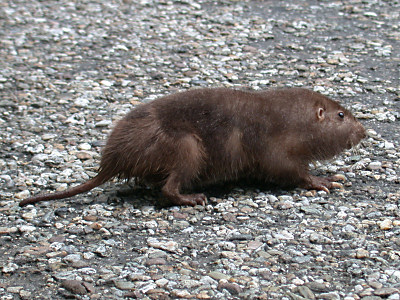
Voorschoten, 3-4-2008
















